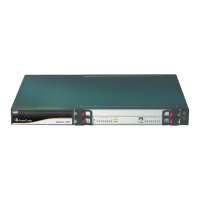User's Manual 1018 Document #: LTRT-89730
Mediant 3000
Parameter Description
Alt Routing Tel to IP Keep
Alive Time
[AltRoutingTel2IPKeepAlive
Time]
Defines the time interval (in seconds) between SIP OPTIONS Keep-
Alive messages used for the IP Connectivity application.
The valid range is 5 to 2,000,000. The default is 60.
Max Allowed Packet Loss
for Alt Routing [%]
[IPConnQoSMaxAllowedPL
]
Defines the packet loss (in percentage) at which the IP connection is
considered a failure and Alternative Routing mechanism is activated.
The default is 20%.
Max Allowed Delay for Alt
Routing
[IPConnQoSMaxAllowedDe
lay]
Defines the transmission delay (in msec) at which the IP connection is
considered a failure and the Alternative Routing mechanism is
activated.
The range is 100 to 10,000. The default is 250.
58.10.12 Alternative Routing Parameters
The alternative routing parameters are described in the table below.
Table 58-67: Alternative Routing Parameters
Parameter Description
3xx Use Alt Route Reasons
[UseAltRouteReasonsFor3x
x]
Defines the handling of received SIP 3xx responses regarding call
redirection to listed contacts in the Contact header.
[0] No = (Default) Upon receipt of a 3xx response, the device tries
each contact, one by one, listed in the Contact headers, until a
successful destination is found. However, if a contact responds with
a 486 or 600, the device does not try to redirect the call to next
contact, and drops the call.
[1] No if 6xx = Upon receipt of a 3xx response, the device tries ea
ch
contact, one by one, listed in the Contact headers. However, if a 6xx
Global Failure response is received during this process (e.g., 600
Busy Everywhere) the device does not try to redirect the call to the
next contact, and drops the call.
[2] Yes = Upon receipt of a 3xx response, the device redirects the
call to the first contact listed in the Contact header. If the contact
responds with a SIP response that is defined in the Reasons for Tel-
to-IP Alternative Routing table, the device tries to redirect the call to
the next contact, and so on. If a contact responds with a response
that is not configured in the table, the device does not try to redirect
the call to the next contact, and drops the call.
Redundant Routing Mode
[RedundantRoutingMode]
Determines the type of redundant routing mechanism when a call can’t
be completed using the main route.
[0] Disable = No redundant routing is used. If the call can’t be
completed using the main route (using the active Proxy or the first
matching rule in the Routing table), the call is disconnected.
[1] Routing Table = (Default) Internal routing table is used to locate

